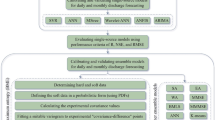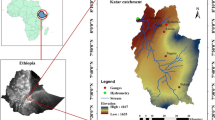Abstract
A red tide is a temporary natural phenomenon in which harmful algal blooms (HABs) can lead to fin fish and shellfish dying en masse. For example, HABs can damage sea farming on the coast of South Korea, and generally have a bad influence on the coastal environment and sea ecosystem. Prediction of red tide blooms, which consists of a categorical type and a numerical type, can minimize the mitigation cost of HAB disasters and the suffering caused by the damage from red tide events. The first type of prediction has high precision but it represents a simple binary result, and the second can predict how much harm an algal increase causes, but its prediction has lower accuracy than the results of the categorical type. To enhance the automatic forecast of red tide, this paper proposes a red tide prediction method that uses fuzzy reasoning and the ensemble method to obtain prediction results for the categorical and numerical types. The proposed method improves the precision of categorical prediction because the ensemble classifier is enhanced by optimal data of the proposed preprocessing. The method forecasts a numerical prediction, such as the increasing density of red tide algae, using the fuzzy reasoning by which the accuracy of numerical results is improved by the proposed post-processing. The experimental results demonstrate that the proposed method achieves a better red tide prediction performance than other single classifiers.



Similar content being viewed by others
References
Red Tide Information System (2012) Korea National Fisheries Research & Development Institute. http://portal.nfrdi.re.kr/redtide/index.jsp. Accessed from 1 January to 28 February 2013
Kim YM, Byun YG, Huh Y, Yu KY (2007) Detection of cochlodinium polykrikoides red tide using MODIS level 2 data in coastal waters. J Korean Soc Civil Eng 27:535–540
Kim JK, Youn HJ (2001) HABs prediction method in Yeosu bay using remote sensing. In: Proceeding of spring conference of Korean society GIS, pp 47–57
Li Y, Smayda T (2000) Heterosigma akashiwo (Raphidophyceae): on prediction of the week of bloom initiation and maximum during the initial pulse of its bimodal bloom cycle in Narragansett bay. Plankton Biol Ecol 47(2):80–84
Song BH, Jung MA, Lee SR (2010) A design and implementation red tide prediction monitoring system using case based reasoning. J Korea Inf Commun Soc 35(12):1819–1826
Fdez-Riverola F, Corchado JM (2004) FSfRT: forcasting system for red tides. Appl Intell 21:251–264
Rong Z, Hong Y, Liping D (2006) Research on prediction of red tide based on fuzzy neural network. Bull Mar Sci 8(1):83–91
Kang IW, Park S, Lee YW, Jeong MA, Oh IW (2011) Tide prediction using neural network. In: Proceeding of 21st joint conference on communications and information
Park S, Lee SR, Park CC, Lim HS, Shin JW, Kwon JW (2011) Red tide blooms prediction using. Fuzzy reasoning. In: Proceeding of spring conference of Korea information processing society
Park S, Lee SR (2011) Red tide prediction using ensemble method. In: Proceeding of fall conference of Korea information and communications society
Park S, Lee SR (2011) Enhancing of red tide blooms prediction using fuzzy reasoning and Naive Bayes classifier. In: Proceeding of summer conference of Korea information and communications society
Sugeno M (1985) Industrial applications of fuzzy control. Elsevier Science, Amsterdam
Han J, Kamber M (2006) Data mining concepts and techniques, 2nd edn. Morgan Kaufmann, San Mateo
Breiman L (1996) Bagging predictors. Mach Learn 24(2):123–140
Fahim M, Fatima I, Lee SY, Lee YK (2013) EEM: evolutionary ensembles model for activity recognition in smart homes. Appl Intell 38(1):88–98
Lee HS, Kim ET, Pedrycz W (2013) A new selective neural network ensemble with negative correlation. Appl Intell 37(4):488–498
Canuto AMP, Santos AM, Vargas RR (2011) Ensembles of ARTMAP-based neural networks: an experimental study. Appl Intell 35(1):1–17
Lee MO, Kim PJ, Moon JH (2006) Influence of marine environment on the occurrence of algal blooms in Jinhae bay. In: Proceeding of spring conference of Korean society for marine environment engineering, pp 177–183
Lee MO, Kim PJ (2006) Characteristics of marine environment and algal blooms in Jinhae bay. In: Proceeding of conference Korean society of civil engineers, pp 2173–2176
Kim JG (2007) A study on the spatial determination of red tide occurrence area using GSIS. J Korean Soc Geospatial Inf Syst 15(2):51–57
Korea National Fisheries Research & Development Institute (2013) http://portal.nfrdi.re.kr/. Accessed from 1 January to 28 February 2013
Korea National Weather Service (2013) http://www.kma.go.kr/index.jsp. Accessed from 1 January to 28 February 2013
Chiu SL (1994) Fuzzy model identification based on clustering estimation. J Intell Fuzzy Syst 2:267–278
Takagi T, Sugeno M (1985) Fuzzy identification of systems and its applications to modeling and control. IEEE Trans Syst Man Cybern 15:116–132
Breiman L, Friedman J, Olshen R, Stone C (1984) Classification and regression trees. CRC Press, Boca Raton
Acknowledgements
This work was supported by Priority Research Centers Program through the National Research Foundation of Korea (NRF) funded by the Ministry of Education, Science and Technology (2009-0093828).
Author information
Authors and Affiliations
Corresponding authors
Rights and permissions
About this article
Cite this article
Park, S., Lee, S.R. Red tides prediction system using fuzzy reasoning and the ensemble method. Appl Intell 40, 244–255 (2014). https://doi.org/10.1007/s10489-013-0457-1
Published:
Issue Date:
DOI: https://doi.org/10.1007/s10489-013-0457-1




